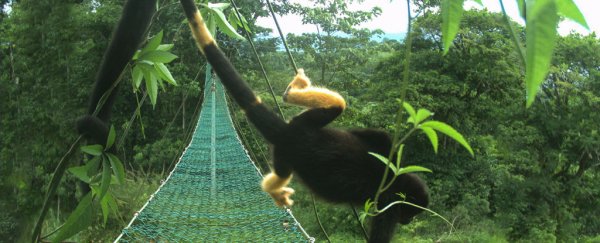The name says it all, really. With the exception of some orange hairs in the rear, the black mantled howler monkey (Alouatta palliata) is predominantly covered in - you guessed it - pitch black fur.
This is true for all the black howler monkeys in the forests of Central America and the north of South America. But in Costa Rica, something strange is going on.
In the past five years, howler monkeys in this region have begun to sprout yellow fur.
At first, it was just a patch or two of creamy yellow on the limbs and tails of a few.
But over time, the curious examples have begun to add up. Scientists have now reported at least 21 howler monkeys with yellow fur, living in the wild along the coast of Costa Rica.
The patches of yellow fur appear to be growing not only in number but also in size. On some monkeys the yellowish pigmentation even outshines the black.
In fact, scientists have reported at least two wild monkeys fully covered in yellow fur, with no black coloration at all.
The rapid changes have been confusing scientists for years, and a close inspection of the monkey's coat now suggests pesticides may be to blame.
Analysing the fur of these Costa Rican anomalies, the researchers found a difference in the type of melanin produced.
Melanin is the pigment that colours hair and skin, and different forms of it can create a variety of colours.
In most black mantled howler monkeys, a pigment called eumelanin reigns, producing black, gray or dark brown fur.
But for some reason, in some howler monkeys, the melanin switches to pheomelanin, which produces yellow, red or orange tones instead.
"These observations represent totally anomalous cases of pigmentation, as these have never been reported in captivity or in the wild before," the authors conclude.
"We are not aware of similar changes in pigmentation in other primates or other groups of mammals."
This marks the first time scientists have noticed such a rapid change in the pigmentation of primate fur, or any other mammal for that matter.
And while it's still not clear exactly why these pigments are changing, pesticides are suspected to be the main culprit.
It turns out, that the pigment responsible for the monkey's yellow fur contains sulfur, and sulfur, incidentally, forms the basis for most pesticides used in the world.
The researchers propose that as these Costa Rican monkeys are exposed to more pesticides, the abundance of sulfur messes with the pigment of their fur, changing the structure of melanin and, therefore, their overall colour.
This isn't some crazy hunch, either. In Costa Rica, pineapple, banana and African palm oil farms have recently begun to use a greater number of sulfur-containing pesticides.
And already scientists are noticing that most animals with unusual colours come from the forests surrounding these farms.
In fact, Costa Rica has some of the highest pesticide use in the world, averaging over 25 kilograms (55 pounds) applied per hectare of cultivated land.
Black howler monkeys may just be the latest victims of these chemicals. In Costa Rica, these monkeys feed mainly on leaves from trees surrounding these sorts of farms.
As such, they probably consume a significant amount of pesticides, which could have the power to influence the resulting melanin.
The idea is certainly interesting, but right now it's just speculation. The researchers say that more research needs to be done to find out the underlying cause of this pigment change.
And it's important that we do just that. All of that bright yellow fur may look harmless, but the conspicuous colour change could make these monkeys more vulnerable to attack from jaguars and other predators.
After all, those poor souls with completely yellow fur stand out like ripe fruit against the dense green forest.
This study has been published in Mammalian Biology.
